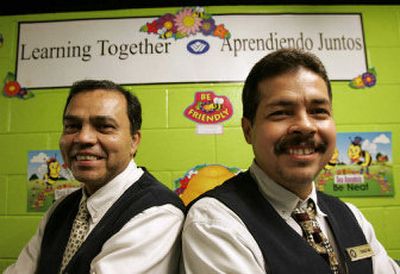Promoting English

DALLAS — Francisco Casas knew enough English to get by in his job preparing rooms for meetings at a luxury hotel, using a few key words such as “table” and “chair” along with hand gestures.
But the 43-year-old Mexican immigrant wanted to improve his language skills, so he jumped at the chance when his company, hotel operator Wyndham International Inc., offered him a basic English course.
“The good thing is my little girl, she’s 6, she’s my little teacher. ‘No Papi, you need to say it like this,”’ Casas said in English, about a month after finishing the program.
The Dallas hotel chain is one of many companies across the country helping immigrant workers learn English as the Hispanic population booms. Officials say the programs can give employees the skills they need to be promoted later in their careers.
“There’s a lot of untapped talent and education because the only barrier is employees who can’t speak English,” said Michelle Miller of the Multicultural Foodservice and Hospitality Alliance, a Providence, R.I., group that promotes the economic benefits of diversity.
The nation’s Hispanic population doubled between 1980 and 2000, making immigrant and U.S.-born Latinos the country’s largest minority group. An estimated 5 million adults with limited English skills work in the service industry, said Dave Henninger, senior vice president for marketing for Retention Education LLC, a California company that oversees language programs for two companies.
Restaurant operator Brinker International Inc., foodservice company Sodexho USA and restaurant chain Cracker Barrel also offer courses like Wyndham’s. Students work on lessons at home using a LeapFrog pad, an electronic book often used to help young children learn to read. The toy features an adult story line resembling a less-racy Latin American novela, backed by salsa and merengue music.
Students touch the book’s pictures with a stylus pen and hear translations and pronunciations. Instructions explain how to mouth the words and give cultural pointers. Students can record and hear pronunciations as many times as they’d like.
“My little boy would say ‘Hey Papi, this is for little boys,”’ Casas said. “Yeah, I know, but I need to learn.”
The average participant at Dallas’ Wyndham Anatole hotel improved 81 percent within 20 days of using the first book. Other methods tried in the past — pocket translators, flash cards, college classes and bringing in teachers — haven’t been as successful, officials said.
Some workers weren’t familiar with computers, so technology-based training wasn’t very helpful. Regular class attendance was difficult because of work and family schedules.
With long waiting lists for English classes and predictions of a work force shortage in 10 years for the restaurant industry, it’s understandable why hotels and restaurants are leading the way in teaching immigrant employees English.
For companies, the classes can build loyalty among employees and identify talented workers. At the same time, the program serves Spanish speakers trying to learn the language they need every day, said Jose Gomez, Brinker’s diversity director.
“Are we doing this as a benefit of the company, absolutely. But we’re also doing it to improve the employees’ life skills,” Gomez said.